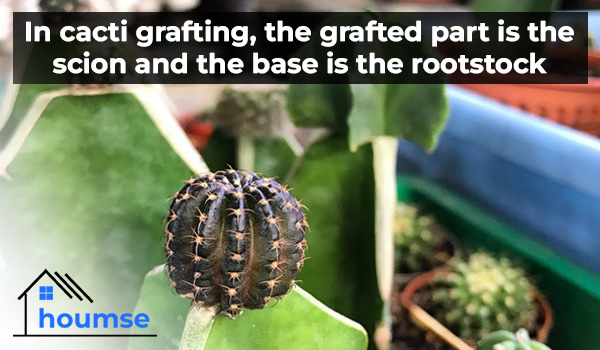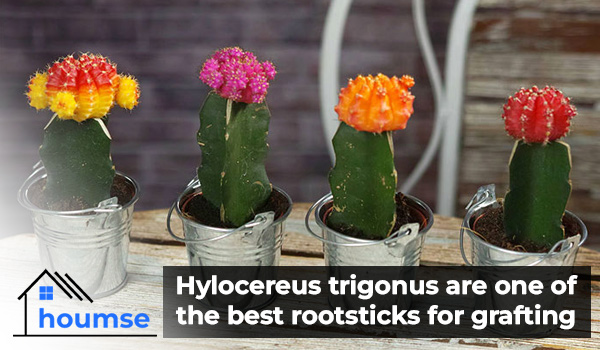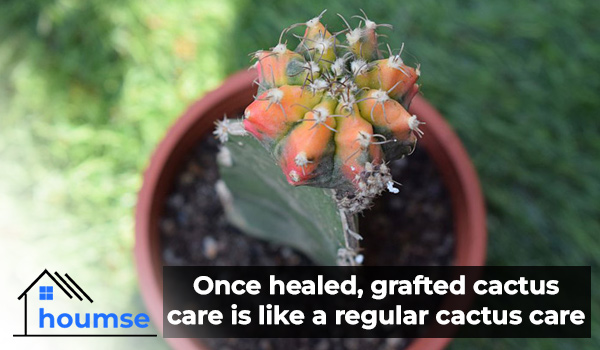Grafting Cactus: Step by Step Guide + Care Tips

Cactus grafting is a common method for cacti reproduction. In different methods of this practice, you grow a cut piece of one plant onto a wounded piece of another. Grafting cactus is an easy method that even novice gardeners can try.
Cacti are unique plants with unusual characteristics. You can reproduce your cactus with stem cuttings, leaf cuttings, seed, or offsets as well, but cactus grafting is probably the best method. In grafting cactus, the grafted part is called a scion and the rooted part (the base) is known as the rootstock.
Growing cactus from seed needs a lot of patience, considering the possibility of unreliable germination and sluggish growth. In general, you can reproduce a cactus that does not produce offsets using this cactus grafting guide, as long as there is a compatible rootstock.
Although all the best cactus for grafting may work better with different methods, our guide here provides you with the main instructions to try this method. Without further ado, let us see how to graft a cactus.
Benefits of Grafting Cactus
People have different reasons for using a cactus grafting guide. Some want to produce different species with disease-free stems, to provide a new stem for an existing and rotting stem to enhance the plant’s photosynthesis. Others use grafting cactus tutorials to create unique forms, like weeping plants. This method is also common for fruiting plants, as it boosts fruit production.
After grafting cactus, the scion becomes the top part of the plant, with all the characteristics of the originating species, and the rootstock becomes the root. The union happens when the scion and rootstock wounds are sealed together to heal and later join.
Also, you can read about: Hairy cactus

Best Rootstock for Grafting Cactus
Before following the tips of the cactus grafting guide, it is a good idea to know the best cactus for grafting. If you choose the rootstock and the scion from the same species, you will have perfect compatibility.
By decreasing the family relationship, the compatibility will decrease as well. There is a possibility to graft two plants in the same genus. But if they are in the same genera or in the same family, the chance of grafting cactus will decrease even more.
Therefore, the best rootstock for grafting is among the ones that are in the same species and have the closest relationship possible. By choosing the best cactus for grafting, you can guarantee the best outcome. The cactus grafting stocks below are approved for this practice:
- Hylocereus trigonus (undatus)
- Trichocereus spachianus
- Cereus peruvianus
- Old lady cactus
Cactus Grafting Tools
After choosing the suitable plants, you need to prepare the cactus grafting tools. Here are the tools that you need in this process:
Cactus Grafting Knife
A cactus grafting knife is designed to deliver the cleanest cut possible. However, you can use other knives. You should use a very sharp knife with a straight edge, and more importantly, it should not be serrated.
Gardening Gloves
You are going to handle spiky cactuses, so it is essential to use a good pair of gardening gloves. A high-quality pair of leather gloves will also be a great investment for future gardening adventures.
Rubber Bands
Rubber bands will help you hold the two plants together while they join and heal. You can also twine instead of rubber bands for grafting cactus.

How to Graft a Cactus
As we mentioned, there are different cactus grafting methods. Each one has a different cut and a place of transplant. In the following grafting cactus guide, we are going to discuss the simplest and the most effective method: the lateral graft.
- Start with precisely cutting the head of the rootstock at your desired height, using a cactus grafting knife or any other clean sharp knife. It should be at least 2 or 3 inches above the soil surface.
- Now to create the scion, cut the head off the other plant. It is best that the scion and the cactus grafting stock (rootstock) have a similar diameter where they will join and heal.
- Look at the sliced part of the plants. You will notice rings or some tubes. These are xylem and phloem. They reside in the vascular cambium tissue of the plant and make new xylem, which are like blood vessels for your cacti. You need to match these rings or tubes as closely as possible. This is the most important part of grafting cactus. If you cut the plants clean and match them right, it will work.
- Finally, hold the graft using rubber bands or twine, from the top of the plant, down, and around its container. If you cannot hold them this way, use a sandwich toothpick to keep the parts together. Although, remember that there is a chance of infection if you use a toothpick (like other wounds).
A couple of weeks after grafting cactus, the plants should be bonded together. Watch for any rot or insects at the union. After about two months, the union should be sealed, and you can remove the rubber bands. You can use this guide to create your own version of the popular moon cactus grafting.
Maintenance of Grafted Cactus
Once healed, grafted cactus care is the same as a regular cactus:
- Light: After grafting cactus, the plant needs a lot of sunlight, but it can burn too. A south-facing window is an ideal location. If you see your cactus turning yellow or brown on the side facing the sun, let it cool down in a different location.
- Water: You might think that cacti do not need that much water because they are from dessert. Actually, grafted cactus maintenance includes regular watering every week. These have a special ability to survive drought, but they still need water. Just make sure the soil is dry between irrigations.
- Soil: Simply use cactus soil available in many nurseries or flower shops. This type of soil is sandier and rockier than regular potting soil and is also very effective for draining excess water. This quality is really important so that your cactus does not get soggy.
- Fertilization: A good fertilizer can make your plant very happy after grafting cactus. You can find specialized fertilizers with the nutrients they need. During the summer growth months, you can fertilize them lightly with every watering, since they prefer small doses regularly. During the winter months, taper off and let the plant rest.

Can You Separate a Grafted Cactus?
Now that you know how to graft a cactus, you may also want to know how to de graft a grafted cactus, which is quite common actually.
Your grafted plant will not last more than a few years, because the cactus grafting stock and scion grow at different rates. This difference in growth rate can eventually ruin the union between the two plants.
In situations like this, all you need to do is separate the scion (like you did for the original grafting) and graft it onto a new grafting cactus rootstock.
Read related articles: coral cactus care
- In this post:
- Benefits of Grafting Cactus
- Best Rootstock for Grafting Cactus
- Cactus Grafting Tools
- How to Graft a Cactus
- Maintenance of Grafted Cactus
- Can You Separate a Grafted Cactus?



